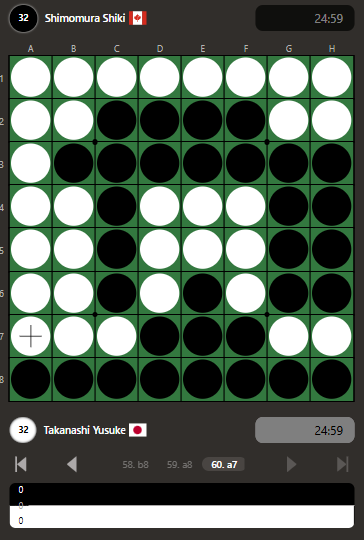Othello news
The Catch-22 Perfect Storm
13 November 2025Written by Guy Plowman

We are now coming towards the end of the first day of the 47th World Othello Championships in Ankara, Turkey.
In round 1, The number one seeded player and multiple World Champion, Yusuke Takanashi, was drawn against the World Championship newbie but still exceptionally strong Japanese player (playing for his country of residence, Canada, in this tournament), Shiku Shimomura.
You can see a full transcript of the game at Flip The Disc: https://flipthedisc.com/live/320/38644 but this article isn't going to be too concerned with the actual spontaneous strategic decisions. Why? Because it is actually questioning whether there were any!!!
Why? Take a look at the final board position below in the image, taking particular notice of the evaluation at the bottom.
You probably notice that the evaluation graph is totally flat. This means that neither player was ahead at any point. It was, at least according to the computer analysis, a perfect game. But how?
We know that top level players prepare openings and that these openings can run very deep. We also know that computers can now analyse to the end of the game from a very long way out and that top players use this analysis in their opening preparation. This gives rise to some questions:
1. Could both players have prepared an opening to the end of the game?
2. Why would they do this and just play out a draw?
The answer to question (1) is yes. When preparing an opening, it is possible to follow through to the end of the game and know in full knowledge that, if that line is played, you will draw. But the expectancy is that your opponent will not be able to play the perfect line and leave you in a winning position (whether you manage to execute it or not, this is obviously an advantage). But, obviously, if both players do this with the same line, it effectively becomes a full game, 60-move opening.
The answer to the second question is partly answered above. You know that you can not lose using the draw line and you know that every move that you make that deviates from the draw line is, at best, still a draw and, at worst, losing.
Now, humans aren't perfect so it is possible that despite playing a less good move, if you are taking your opponent off the draw line that they know, they might also make another less good move in their follow up (with imperfect knowledge of the alternative lines). If both players are out of book, it becomes an open game again...
...except that, where the opening preparation is sufficiently deep, we will be near the end of the game and there isn't much room for top players to make a mistake in their calculations. So playing off the prepared draw line is a high risk strategy.
So, why doesn't one or other player consider playing off the draw line sooner, taking both players out of book earlier when the risk of perfect play is lower? This is where the Catch-22 of my title comes in. The expectancy is that your opponent hasn't looked at exactly the same line as you all the way to the end of the game. But how can you tell how deep their preparation is without seeing the moves they actually play? It isn't until you reach the later stages that each player realises that deviation will only lose the game. They might then think 'I wish that I had deviated sooner when I had the chance' but, by this point it is too late. So the draw just gets played out.
On the one hand, this makes a frustrating result to watch. Both players playing the game to the end (quickly), without apparent fault. On the other hand, the likelihood of both player having prepared the same opening so deeply on opposing sides is very rare given the tens of millions of possible Othello games and it is an intriguing (albeit incredibly rare) possibility of tournament play where both players essentially (and often undesirably) lose half a point on the field.
I would love to hear your thoughts on 60 move openings...




